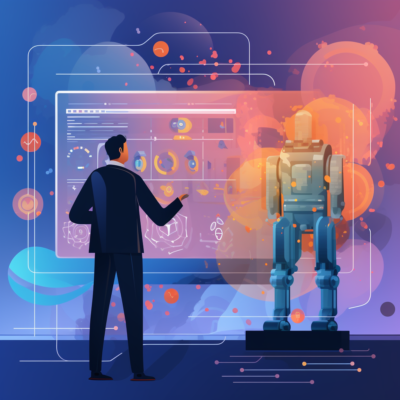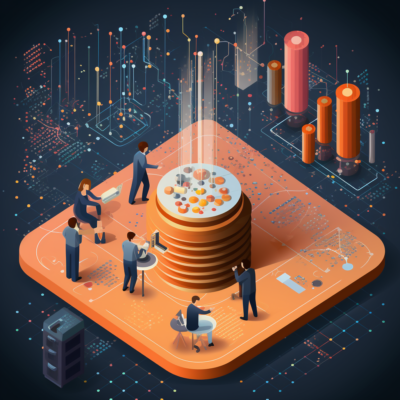
When headlines announcing the word of the year hit the news (hello “authentic,” hello “rizz”), I was surprised “AI” didn’t make the cut. Artificial intelligence has obviously been a major topic among the data and analytics professionals IIA interacts with, but it’s also been a major topic everywhere.
A natural extension of all this buzz around AI is the topic of who owns (or should own) AI in the enterprise. For companies who want to mature into AI production scenarios or use AI enabled applications to upend their industry, this is a critical question to address. If a company wants sustained AI success, senior leadership must ask and align on: Who is ultimately responsible for AI initiatives in our complex enterprise environment?
Who Owns AI in the Business?
While folks in data and analytics circles have been having substantial conversations about AI for some years now, the issue of enterprise-wide ownership has been a distant concern for most. Until recently, AI was not top of mind for most CEOs and boards at F1000 organizations still working their way through digital transformations. But that all changed overnight with the release of OpenAI’s GPT for public consumption in November 2022. Now, I like to think of myself as an even-keel guy when it comes to potentially new and exciting things (e.g., never really got excited about blockchain), but the recent advancements in generative AI and LLMs are truly transformative. This has the potential to impact so many roles and processes that have not been disrupted before.
Given the stakes of this technology, this way of working and decision-making for enterprises, it’s no surprise then that Paul Baier, one of IIA’s experts, recommends that “CEOs need to establish one leader as the go-to person for all things GenAI during this rapid learning phase.”
Yet, this recommendation does beg the question: Where should AI go on the org chart, especially for large, non-digital-native companies? Because Generative AI is seen as such an accessible tool, this is not an easy question. Should it live with the chief data officer, chief analytics officer, or chief data analytics officer? Should companies create a chief AI officer role? Should it live on the innovation side of the house? Here’s a short-list of likely suspects:
- Chief Data Officer (CDO)
- Chief Analytics Officer – or Chief Data Analytics Officer (CAO; CDAO)
- Chief Information Officer (CIO)
- Chief Technology Officer (CTO)
- Head of Innovation
- Chief Digital Officer
- Chief AI Officer (CAIO)
- Head of Strategy
- Head of Product
- CEO
Gary Cao, a seasoned data and analytics leader with over 20 years of experience at various organizations, and who has experience with a number of diverse reporting structures, advocates for enterprises to create the chief AI officer role–or convert existing head of data and analytics titles into this new label. He reasons that CDAOs will “gain more strategic visibility, have a better chance to deliver business impact, and move closer to the decision-making circle.”
For Cao, this is part role definition, part internal marketing: “AI is the more polished word to replace (and be an extension of) ‘analytics.’ It is more sophisticated, technology-enabled, scalable, deeply rooted in operational process and human behavior, more forward-looking, and potentially leading to fundamental changes in organizations.”
As a counterpoint, let’s delve into a research brief penned by Tom Davenport, co-founder of IIA, specifically for clients in our Research and Advisory Network. The brief is titled “Succeeding as a Chief Data and Analytics Officer: The Quest for Visible Value.”
Many of the CDAOs in the survey mentioned that data, analytics, and AI have the potential to create new strategies, processes, business models, products, or services. This is one of the most important and visible sources of business value. As Bill Groves, the former CDAO of Walmart and IIA Expert put it, “This is not a service organization; it's a transformation organization.”
Offense-oriented initiatives are an effective way to achieve value. There was a strong focus on offense among the CDAOs interviewed. Groves commented, “To sit at the C-level table you have to have offense.” Offense-oriented initiatives involve making decisions that increase revenues or profits, helping to develop new products and services, or enhancing customer loyalty and relationships. As Heidi Lanford, CDO of Fitch, described her team’s role on offense:
“My group’s mandate is exploitation of our data to build products. We want to transform how we leverage data to enhance products and applications. The focus is on data as a product. What does that mean? Scaling data for new products and determining how to monetize it more than we already do.”

Developing a Product Orientation for Analytics and AI eBook
There is one primary reason why organizations need to adopt a product focus for analytics and AI: models simply don’t get implemented often enough. Delve into the benefits of product orientation and how get started in our eBook below.
At the time of this survey, 66% of the survey respondents spent at least 20% of their time on “enabling new business initiatives based on data/analytics/AI; 50% spent at least 20% of their time on “producing analytical or AI-based insights for the organization.”
These are CDAOs clearly on the quest for visible value, and when I consider the short-list of likely AI suspects above, these CDAOs provide a good model of AI ownership for enterprises now and in the future.
Why is the CDAO best suited to own AI?
The CDO, CAO, or CDAO has been owning AI initiatives all along. Maybe this hasn’t been explicitly stated in some organizations, but they’ve been creating and deploying statistical and machine learning models for years to drive business value.
AI is a stochastic system. Your CDAO knows how to deal with variability and randomness and uncertainty. AI is not deterministic. It is possible to get wrong answers and we have to be prepared to deal with that.
Most of our AI work is focused on augmenting/changing existing processes. This is the realm of the CDAO. Data and analytics has always involved taking a consultative approach and partnering with those in other parts of the organization. With the fairly recent adoption of product management philosophies by many in the data and analytics space, the CDAO is also well-equipped to handle new offerings powered by AI.
Generative AI involves data. Whether you plan to train your own model, fine-tune a model, or use embeddings, you’ll need the appropriate data. That data will need to be managed and governed, using processes that the CDAO has been honing for years.

Creating a Data Strategy eBook
A comprehensive data strategy is not optional. Let our data strategy framework guide you on your journey towards achieving more analytics success.
If your organization doesn’t yet have a CDAO, this is the time to take the plunge.
While it is important to know who owns such a transformational technology as this, never lose sight that AI is a team sport. Many will be involved. You’ll need technology leadership to partner with business unit owners. You’ll need to bring in legal, risk, HR, and others. This will be a cross-functional team at its finest.
We’d love to hear what you think!
- Is this a topic of discussion at your organization?
- Who owns AI in your organization?
- Who do you think should own AI?
- Does it even need an owner